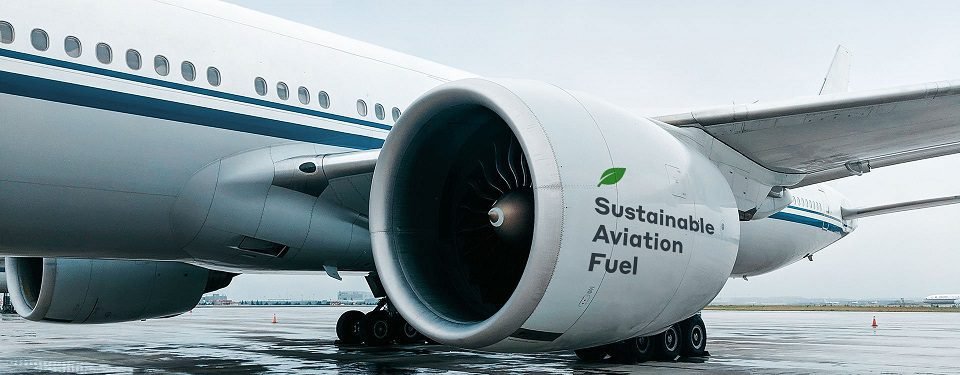Sustainable Aviation Fuel
Consider planes flying as harbingers of a greener, more sustainable future, not climate change culprits. Sustainable Aviation Fuel (SAF) combines innovation and environmental responsibility to clean up the aviation sector.
Key takeaways:
- SAF is Gaining Momentum: Sustainable Aviation Fuel (SAF) is rapidly becoming a mainstream solution for cleaner air travel.
- Airlines Are Embracing SAF: Leading airlines are actively using SAF to reduce emissions and boost sustainability.
- Global Recognition: SAF aligns with international agreements, emphasising its importance in reducing aviation emissions.
- Reducing Greenhouse Gas Emissions: SAF significantly cuts greenhouse gas emissions compared to conventional jet fuel.
- Long-Term Economic Benefits: While SAF may cost more upfront, it offers long-term economic benefits and future-proofing for airlines.
- Driving Innovation: SAF stimulates innovation and research in aviation technologies and sustainability.
A whisper of change is rising in the air in a world where the skies have long been identified with the roar of jet engines and the trail of carbon emissions. Imagine planes flying through the sky without using fossil fuels but instead relying on the promise of sustainability. Welcome to the amazing world of Sustainable Aviation Fuel (SAF), where green is the color of the future of flying.
In the big picture of what the world is doing to fight climate change, the aircraft business is often looked at closely for its impact on the environment. Traditional jet fuel gives off a cloud of carbon dioxide when a plane takes off or lands. This adds to the complicated puzzle of greenhouse gas emissions. But in this confusing time, when sustainability is no longer a choice but a must, the airline business is about to change in a big way.
Sustainable Aviation Fuel, or SAF, is the bright light of hope in this project. It’s a big change from the old way of using fossil fuels, and it could lead to cleaner air and a better world. As the world tries to deal with the effects of climate change, the airline industry is taking bold steps toward a more sustainable future, and SAF is at the center of this change.
In this piece, we take a trip through the world of sustainable aviation fuel, looking at what it is, how it is made, and how it affects the earth. We get into the details of feedstock sources and licensing standards to figure out how SAF fits into the bigger picture of sustainable flight. As we make our way through this complicated terrain, we’ll also learn about the economic factors and difficulties that lie ahead, as well as the bright future that sustainable aviation fuel holds.
But this is really a story about hope and new ideas. It’s a story that tells us that even when people are facing huge problems, they can still change and move forward. Join us as we take off into the world of sustainable aviation fuel. This is a trip that captures the spirit of a green change, where the skies are no longer just blue but also deeply, unmistakably green.
Defining Sustainable Aviation Fuel
In the labyrinthine landscape of aviation and its relentless pursuit of sustainability, one term stands out as both a beacon of hope and a source of curiosity: sustainable aviation fuel, or SAF. In this section, we embark on a journey of comprehension, aiming to unravel the intricacies of SAF, its composition, and its stark departure from conventional aviation fuel.
What is sustainable aviation fuel?
Let’s start at the heart of the matter. Sustainable Aviation Fuel, often abbreviated as SAF, is not your run-of-the-mill aviation fuel. It’s not a mere alternative; it’s a transformational paradigm shift in the aviation industry. SAF is a specialised biofuel formulated to power aircraft, but with a key distinction—it’s derived from sustainable and renewable sources.
At its core, SAF shares some fundamental chemical similarities with traditional jet fuel. It primarily consists of hydrocarbons, just like the fuel that has propelled aircraft for decades. However, the magic of SAF lies in the sources from which it’s derived and the process by which it’s produced.

Differentiating SAF from Conventional Jet Fuel
To truly understand SAF, it’s essential to grasp how it diverges from the conventional jet fuel that has been the lifeblood of aviation for so long. Conventional jet fuel, commonly known as Jet A or Jet A-1, is derived predominantly from fossil sources—crude oil, to be precise. This oil-based fuel, while efficient, has a substantial environmental downside, as it releases carbon dioxide (CO2) and other pollutants when burned.
The Environmental Advantages of SAF
In stark contrast, SAF is a game-changer when it comes to the environment. Its feedstock, the raw materials from which it’s produced, is sourced from sustainable and renewable resources, ranging from agricultural waste and algae to cooking oils and even municipal solid waste. This diverse range of feedstock options enables SAF to be a significantly cleaner and greener alternative to conventional jet fuel.
The critical differentiator is SAF’s potential to significantly reduce greenhouse gas emissions, including carbon dioxide. When SAF is combusted in aircraft engines, it emits substantially fewer CO2 emissions compared to its conventional counterpart. This reduction in carbon emissions is a pivotal step in addressing aviation’s considerable environmental impact.
As we navigate the labyrinth of aviation sustainability, SAF emerges as a promising solution—a testament to human ingenuity and determination to steer the aviation industry toward a greener future. In the following sections, we’ll explore the fascinating world of SAF production, the various feedstock sources that power it, and the rigorous certification standards that ensure its sustainability. It’s a journey through the heart of a green revolution in the skies, where complexity meets innovation and curiosity meets hope.
The Urgency of Sustainability in Aviation
In the vast and ever-expansive skies, where the horizon knows no boundaries, a pressing concern looms larger than any cumulonimbus cloud—a concern that has propelled aviation into an era of unparalleled urgency: sustainability. This section embarks on a journey through the atmospheric shifts of the aviation industry, where the winds of change are not just a metaphor but a clarion call for a more sustainable future.
Climate Change Challenges in Aviation
It’s hard to describe how captivating it is to see a jet’s contrail arc over the blue sky. But there is a complicated environmental problem behind this visual beauty. Even though the aircraft industry is a marvel of human engineering and desire, it has been under a lens for a long time because of climate change.
The Carbon Conundrum
At the heart of this scrutiny is the industry’s prodigious production of greenhouse gas emissions, with carbon dioxide (CO2) taking centre stage. Jet engines, powered by conventional fossil-based aviation fuel, release CO2 and other pollutants into the atmosphere with every flight. This contribution to the greenhouse effect is a formidable challenge in the fight against global climate change.
Rising Emissions and International Commitments
Aviation emissions have been on an upward trajectory for years, driven by a surge in air travel and cargo transportation. The aviation sector accounts for a significant and growing share of global emissions, and this trend raises alarm bells for climate scientists, policymakers, and environmental advocates.
In response to this ecological urgency, the aviation industry has committed to reducing its carbon footprint. International agreements and targets, such as the International Civil Aviation Organization’s (ICAO) CORSIA program and national commitments to net-zero emissions, have become the cornerstone of aviation sustainability efforts. These initiatives represent a global consensus on the need to address aviation emissions and embrace more eco-friendly alternatives.
Regulatory Pressures and Emissions Reduction Goals
Navigating the turbulent skies of sustainability is not a solo endeavour; it’s a synchronised dance with regulators and governing bodies worldwide. The aviation industry faces mounting regulatory pressures and emissions reduction goals, pushing it further into the realm of environmental responsibility.
Emissions Reduction Goals
Governments, environmental organisations, and industry stakeholders have set ambitious emissions reduction targets. These targets call for a significant decrease in aviation emissions over the coming decades, with the ultimate goal of achieving carbon neutrality. The aviation industry is on notice: the days of business as usual are numbered.
The CORSIA Framework
One of the pivotal pillars of emissions reduction is the Carbon Offsetting and Reduction Scheme for International Aviation (CORSIA). This global program, developed by ICAO, aims to cap international aviation emissions at 2020 levels. Any emissions exceeding this cap must be offset through investments in environmental projects. CORSIA is a concrete step toward achieving sustainability in international aviation and aligns with the industry’s commitment to mitigating its environmental impact.
The Need for Sustainable Solutions
In the midst of these regulatory pressures, climate change challenges, and international commitments, the aviation industry finds itself at a crossroads. The need for sustainable solutions has never been more apparent. Sustainable Aviation Fuel (SAF) emerges as a beacon of hope, a tangible step toward a greener, more responsible future.
As we delve deeper into the world of SAF, we’ll uncover how this innovative biofuel is poised to revolutionize aviation sustainability. SAF is not merely an alternative to conventional aviation fuel; it’s a testament to human ingenuity, a triumph of sustainability, and a testament to our ability to navigate the labyrinthine challenges of the skies with a clear sense of purpose. It’s a journey where the urgency of sustainability meets the promise of change—a journey that embraces complexity and curiosity and, most importantly, fosters hope for a greener aviation industry.
Feedstock Sources for Sustainable Aviation Fuel (SAF)
In the intricate web of sustainable aviation, where innovation meets environmental stewardship, one of the critical underpinnings of sustainable aviation fuel (SAF) lies in the sources from which it is born. This section is a voyage into the diverse and fascinating world of SAF’s feedstock sources, where the quest for sustainability takes root.
Various Feedstock Options
Sustainable Aviation Fuel is as versatile in its origins as it is impactful in its purpose. The magic of SAF begins with the selection of feedstock, the raw materials from which it derives its green credentials. Here, we delve into the myriad options that fuel the production of SAF.
Biomass: Nature’s Offering
One of the most prominent feedstock sources for SAF is biomass. Biomass comprises organic materials such as agricultural residues, forest residues, energy crops, and algae. These renewable resources are a testament to the potential of harnessing nature’s bounty for aviation sustainability.
Agricultural Residues: Crop residues, like wheat straw and corn stover, are ideal biomass feedstock options. They represent a sustainable way to repurpose agricultural waste.
Forest Residues: The remnants of timber harvesting, such as wood chips and branches, can be transformed into SAF, providing an eco-friendly solution to forestry waste.
Energy Crops: Dedicated energy crops like switchgrass and miscanthus offer a renewable feedstock source that can be cultivated specifically for SAF production.
Algae: The enigmatic world of algae presents an exciting frontier for SAF. Algae can be cultivated with minimal land use and can provide high oil yields for biofuel production.
Waste-to-Fuel: Recycling Potential
Waste materials, often discarded without a second thought, find new life in the creation of SAF. The concept of waste-to-fuel embodies the principles of recycling and resource efficiency.
Municipal Solid Waste (MSW): SAF can be synthesized from organic components of municipal solid waste, diverting waste from landfills and incineration.
Used Cooking Oils (UCOs): The oils used in frying and food preparation can be collected and repurposed into SAF, offering a sustainable solution to an everyday waste product.
Animal Fat: Animal fat, a byproduct of meat production, can be utilized as a feedstock source, reducing waste and creating value from a previously discarded material.
Production Processes: Crafting the Green Elixir of Aviation
In the grand symphony of sustainability that is Sustainable Aviation Fuel (SAF), the magic truly unfolds in the production processes. Here, we venture into the alchemical world, where raw feedstock is transformed into the eco-friendly elixir that propels aircraft into the skies, all while mitigating the environmental impact. Brace yourself for a journey through the complex, yet captivating, realm of SAF production.
Overview of SAF Production Methods
To understand SAF’s intricate production, it’s vital to acquaint ourselves with the various methods that bring this green revolution to life. The diverse arsenal of production techniques reflects the multifaceted nature of SAF.
Hydroprocessed Esters and Fatty Acids (HEFA)
HEFA is one of the most established SAF production methods, relying on feedstock like vegetable oils and animal fats. Through a series of chemical reactions, these feedstocks are transformed into hydrocarbons that mimic traditional aviation fuels.
Pros: HEFA has a high energy density, making it a direct substitute for conventional jet fuel. It’s also compatible with existing aircraft engines and infrastructure.
Cons: The feedstock choices can be limited, and the process can have a relatively high carbon footprint depending on the feedstock source.
Fischer-Tropsch (FT)
The Fischer-Tropsch process synthesizes hydrocarbons from a range of feedstocks, including coal, natural gas, and biomass. The result is a synthetic fuel that can be blended with conventional jet fuel.
Pros: FT SAF has a high energy density and is compatible with existing aircraft and infrastructure. It offers versatility in feedstock selection.
Cons: The feedstock sources can vary significantly in terms of environmental impact. Coal-based FT SAF, for instance, has a high carbon footprint.
Alcohol-to-Jet (ATJ)
ATJ is a promising newcomer to the SAF production landscape. It converts alcohols, such as ethanol, into jet fuel components through a catalytic process.
Pros: ATJ has the potential to utilize a wide range of feedstock, including sustainable ethanol sources. It’s also seen as a more efficient and potentially lower-cost method.
Cons: It is still in the early stages of commercialization, and large-scale production is not yet widespread.
Energy Requirements and Emissions
While SAF production holds the promise of greener skies, it’s not without its own energy demands and emissions. Understanding the complexities of these factors is essential to assessing the environmental impact of SAF.
Energy Intensity
Producing SAF can be energy-intensive, with factors like feedstock processing, hydrogen production, and facility operations contributing to energy consumption.
Emissions during Production
Emissions during SAF production can vary significantly based on feedstock sources and production methods. It’s crucial to consider the emissions associated with SAF’s journey from feedstock to final fuel.
Technological Advancements in SAF Production
The aviation industry, in its pursuit of sustainability, is not resting on its laurels. Technological innovations are shaping SAF production, offering solutions to reduce energy consumption, emissions, and costs.
Advanced Catalysts: The development of more efficient catalysts can enhance the conversion of feedstock into SAF, reducing energy requirements.
Renewable Hydrogen: Integrating renewable hydrogen into SAF production can further reduce emissions and reliance on fossil fuels.
Carbon Capture and Utilization (CCU): CCU technologies can capture and repurpose carbon emissions generated during SAF production, making the process more environmentally friendly.
Scaling Up: Increasing the scale of SAF production facilities can improve economies of scale and reduce costs.
The intricate dance of feedstock selection, production methods, and technological advancements defines the SAF production landscape. It’s a realm where complexity meets innovation and where the aviation industry’s commitment to sustainability takes shape. In the next chapters of our journey, we’ll explore the rigorous certification standards that ensure SAF’s sustainability and how this revolutionary fuel is poised to transform the aviation industry’s environmental footprint.
Certification and Quality Standards: Safeguarding Sustainability in SAF
In the dynamic world of sustainable aviation fuel (SAF), ensuring environmental integrity and adherence to sustainability goals is not just an aspiration but a fundamental imperative. This section takes us deep into the heart of SAF certification and quality standards, where meticulous criteria define the green credentials of this revolutionary aviation fuel.
International Sustainability Certification Schemes
Certification and quality standards for SAF are the cornerstones of transparency and accountability in the aviation industry’s sustainability efforts. Several international certification schemes play a pivotal role in assessing and verifying SAF’s adherence to stringent environmental and social criteria.
ASTM D7566: The SAF Gold Standard
One of the most recognized and widely adopted standards for SAF is ASTM D7566, developed by ASTM International (formerly known as the American Society for Testing and Materials). This comprehensive standard defines the specifications and criteria that SAF must meet to be considered a viable alternative to conventional aviation fuel.
Stringent Requirements: ASTM D7566 outlines strict compositional and performance requirements, ensuring that SAF is compatible with existing aircraft engines and infrastructure.
Sustainability Criteria: The standard includes sustainability criteria that SAF must fulfill, including greenhouse gas emissions reductions and adherence to feedstock sustainability guidelines.
ISCC: The International Sustainability and Carbon Certification
ISCC, or International Sustainability and Carbon Certification, is another globally recognized certification scheme for SAF. It focuses on sustainability, traceability, and environmental responsibility.
Sustainability Audits: ISCC conducts audits of SAF production facilities to verify their compliance with sustainability and traceability requirements.
Life Cycle Analysis: ISCC assesses SAF’s environmental impact throughout its lifecycle, including feedstock cultivation, processing, and end-use.
RSB: The Roundtable on Sustainable Biomaterials
The Roundtable on Sustainable Biomaterials (RSB) is yet another influential player in SAF certification. RSB’s standards emphasize sustainability, social responsibility, and ethical practices.
Sustainability Principles: RSB’s standards encompass social and environmental principles, promoting responsible sourcing of feedstock and equitable practices throughout the supply chain.
Global Recognition: RSB is globally recognized for its rigorous sustainability criteria, making it a preferred choice for SAF producers committed to ethical and eco-friendly production.
Ensuring SAF Meets Quality and Environmental Standards
Certification and quality standards are not just bureaucratic checkboxes; they are the guardians of SAF’s promise of sustainability. They ensure that SAF not only performs seamlessly in aircraft engines but also upholds its commitment to reducing greenhouse gas emissions and conserving resources.
Traceability and Transparency: Certification schemes demand traceability and transparency throughout the SAF supply chain, from feedstock sourcing to production and distribution. This ensures that the fuel’s sustainability claims are verifiable.
Environmental Impact Assessment: SAF must undergo rigorous environmental assessments to quantify its carbon footprint and other environmental impacts. These assessments help identify areas for improvement in SAF production and feedstock sourcing.
Ethical and Social Responsibility: Some certification schemes, like RSB and ISCC, place a strong emphasis on ethical and social responsibility, ensuring that SAF production benefits local communities and respects human rights.
As the aviation industry advances toward a more sustainable future, SAF certification and quality standards stand as the sentinels of environmental responsibility. In our next chapter, we’ll unravel the environmental and economic impacts of SAF, highlighting its potential to reduce greenhouse gas emissions and shape a greener aviation industry.
Greenhouse Gas Emissions Reduction: Charting the Path to Cleaner Skies
In the realm of sustainable aviation fuel (SAF), perhaps nothing captures the imagination and urgency more than the promise of reducing greenhouse gas emissions. This section takes us on a captivating journey into the pivotal role SAF plays in mitigating aviation’s carbon footprint and shaping a more sustainable future for the industry.
Quantifying the Reduction in GHG Emissions
To grasp the monumental impact of SAF, we must first delve into the numbers, those unmistakable markers of change. SAF has the potential to significantly reduce greenhouse gas (GHG) emissions compared to conventional jet fuel. It’s not just a marginal improvement; it’s a transformative leap in environmental responsibility.
Carbon Dioxide (CO2) Reduction
When SAF takes flight in aircraft engines, it produces substantially fewer carbon dioxide emissions than its fossil-based counterpart. This reduction in CO2 emissions is not merely a marginal improvement; it’s a game-changer for aviation’s carbon footprint.
Other GHG Reductions
SAF doesn’t stop at reducing CO2 emissions; it also curtails emissions of other greenhouse gases, such as nitrogen oxides (NOx). These reductions contribute to a cleaner and more sustainable aviation industry.
SAF’s Contribution to Carbon Neutrality
In a world where the urgency of climate change is felt across industries, SAF emerges as a powerful tool in aviation’s commitment to carbon neutrality. Achieving carbon neutrality means balancing the emissions produced with emissions removed from the atmosphere—a monumental undertaking for an industry as dynamic as aviation.
Offsetting Emissions
SAF plays a crucial role in achieving carbon neutrality by substantially reducing emissions. Any emissions that do occur can be offset through investments in environmental projects, such as reforestation, renewable energy development, or carbon capture technologies.
A Sustainable Loop
The beauty of SAF’s contribution to carbon neutrality lies in its circularity. By reducing emissions and offsetting those that remain, SAF creates a sustainable loop where aviation’s impact on the environment is not just minimized but actively reversed.
Case Studies: Airlines Leading the Way
To understand SAF’s real-world impact, we need to look no further than the airlines that have already embraced this eco-friendly fuel. These pioneers are not just talk; they are action, embodying the potential and promise of SAF.
Delta Air Lines
Delta Air Lines, a global leader in sustainable aviation, has made significant strides in integrating SAF into its operations. The airline’s commitment to reducing emissions includes regular SAF use and investments in sustainable fuel production.
United Airlines
United Airlines has set ambitious sustainability goals, with a commitment to reducing its greenhouse gas emissions by 100% by 2050. SAF plays a crucial role in achieving these targets, with United actively incorporating the fuel into its flights.
Alaska Airlines
Alaska Airlines made history by operating the first-ever SAF-powered commercial flight in the United States. The airline’s pioneering spirit underscores the viability and potential of SAF in commercial aviation.
SAF: A Transformative Force in Aviation Sustainability
In the intricate tapestry of aviation’s quest for sustainability, SAF emerges as a transformative force. It is not just an alternative fuel; it’s a commitment to reducing carbon emissions, achieving carbon neutrality, and charting a course toward cleaner skies.
As we continue our journey through the world of SAF, we’ll explore the economic considerations of this eco-friendly fuel and how it’s reshaping the aviation industry’s cost structure. SAF isn’t just about sustainability; it’s also about economic viability, and in our next chapter, we’ll uncover the financial implications of embracing this green revolution in the skies.
Economic Considerations: Navigating the Cost and Benefits of Sustainable Aviation Fuel
In the dynamic landscape of aviation sustainability, where the skies are increasingly painted green with Sustainable Aviation Fuel (SAF), the balance between environmental responsibility and economic viability takes center stage. This section embarks on a journey into the economic considerations of SAF, exploring the cost factors, incentives, and long-term benefits that shape the aviation industry’s transition to a greener future.
The Cost of SAF vs. Conventional Jet Fuel
To understand the economic implications of SAF, we must first explore the critical question: how does the cost of SAF compare to that of conventional jet fuel? It’s a query that weighs heavily on airlines and the aviation industry as a whole.
SAF Price Dynamics
The price of SAF has historically been higher than that of conventional jet fuel, primarily due to the complexities and costs associated with its production. However, SAF prices are subject to fluctuation and can vary based on factors like feedstock availability and production scale.
Incentives and Subsidies
Governments and industry stakeholders worldwide have recognized the importance of SAF in reducing aviation’s carbon footprint. To incentivize SAF adoption, various financial incentives and subsidies have been introduced. These can significantly offset the higher cost of SAF and make it a more economically attractive option.
Long-Term Economic Benefits
While the upfront cost of SAF may be higher, its long-term economic benefits extend far beyond immediate expenditure. Airlines and the aviation industry as a whole stand to gain substantially from embracing SAF in the following ways:
Future-Proofing Operations
By investing in SAF, airlines future-proof their operations against rising carbon pricing, emissions regulations, and the increasing demand for sustainable travel options. This proactive approach can save airlines from potential financial penalties down the road.
Enhanced Reputation
Airlines that lead the charge in sustainability and SAF adoption can benefit from enhanced brand reputation and customer loyalty. Passengers increasingly prioritize eco-friendly travel options, and airlines that align with these values can attract a more environmentally conscious customer base.
Environmental and Regulatory Compliance
The aviation industry faces mounting pressure to reduce its carbon footprint and achieve emissions reduction targets. SAF not only aids in meeting these regulatory requirements but also positions airlines as responsible corporate citizens, which can have economic advantages in the long run.
Long-Term Cost Predictability
As the production of SAF scales up and becomes more mainstream, it’s likely that prices will become more predictable and competitive. This predictability can be advantageous for airlines in terms of budgeting and financial planning.
The Crucial Role of Government Policies
Government policies and regulations play a pivotal role in shaping the economic landscape of SAF adoption. Incentives, subsidies, and carbon pricing mechanisms introduced by governments can significantly impact the cost-effectiveness of SAF.
Policy Support
Countries and regions that prioritize sustainable aviation and enact supportive policies can create a favorable environment for SAF adoption. Policy measures can include tax incentives, grants, and mandates for SAF use.
The Role of Carbon Pricing
Carbon pricing mechanisms, such as carbon taxes or cap-and-trade programs, can have a substantial impact on the relative cost of SAF compared to conventional jet fuel. These mechanisms incentivize emissions reductions and make SAF a more attractive option.
In the intricate dance of economics and sustainability, SAF emerges as a transformative force, reshaping the aviation industry’s cost structure and financial outlook. As we navigate the evolving landscape of SAF, we’ll delve deeper into its promise as a driver of innovation, job creation, and economic growth, revealing the multifaceted nature of this green revolution in aviation.
Supply Chain and Scaling Challenges: Navigating the Complex Path of SAF Production
In the grand quest for sustainable aviation fuel (SAF) and its pivotal role in aviation sustainability, one cannot overlook the intricacies of the supply chain and the formidable challenges of scaling up production. This section takes us on a captivating journey into the complexities of SAF’s supply chain and the hurdles that must be surmounted to meet the growing demand for this eco-friendly aviation fuel.
The SAF Supply Chain: A Delicate Balancing Act
The SAF supply chain is a delicate dance of feedstock sourcing, production, distribution, and certification. Each step in this intricate process comes with its own set of challenges and considerations.
Feedstock Sourcing
Sourcing the diverse range of feedstocks required for SAF production can be a logistical puzzle. It involves coordinating with various suppliers, ensuring feedstock sustainability, and maintaining a consistent supply.
Production Challenges
The production of SAF is a complex and energy-intensive process. It demands precise engineering, advanced technologies, and rigorous quality control to meet certification standards.
Distribution Logistics
Distributing SAF to airports around the world requires a well-coordinated logistical effort. Ensuring that SAF is available where it’s needed, while maintaining its integrity and sustainability, is a considerable challenge.
Certification and Compliance
Certification and compliance with sustainability standards add another layer of complexity to the supply chain. Ensuring that SAF meets the stringent criteria of international certification schemes is essential for its acceptance and adoption.
Scaling Up SAF Production: The Road Ahead
As the aviation industry intensifies its commitment to sustainability, scaling up SAF production becomes paramount. Meeting the growing demand for SAF requires overcoming significant challenges.
Feedstock Availability
Scaling up SAF production necessitates a steady supply of feedstock. This can be challenging, as some feedstock sources, such as algae or advanced biofuels, may have limited availability or face competition with other industries.
Technological Innovation
Innovations in SAF production technologies are essential to scaling up. Improving the efficiency of SAF production processes can reduce costs and increase production capacity.
Infrastructure Investment
Expanding the infrastructure for SAF production, transportation, and distribution requires substantial investment. Building new production facilities and retrofitting existing ones to produce SAF on a large scale is a significant undertaking.
Regulatory Support
Government policies and regulations can play a crucial role in supporting the scaling of SAF production. Incentives, subsidies, and mandates can incentivize investment in SAF infrastructure and production capacity.
Collaboration and Innovation: Keys to Overcoming Challenges
Navigating the complexities of the SAF supply chain and scaling challenges requires collaboration and innovation across industries and sectors. Key stakeholders, including airlines, fuel producers, governments, and environmental organizations, must work together to find solutions.
Public-Private Partnerships
Collaborative efforts between governments and private industry can drive investment in SAF infrastructure and research and development.
Research and Development
Continued research into feedstock development, production technologies, and supply chain optimization is essential for overcoming challenges and making SAF production more efficient and cost-effective.
Market Incentives
Creating market incentives for SAF adoption, such as carbon pricing mechanisms, can stimulate demand and drive investment in SAF production.
In the intricate landscape of the SAF supply chain and scaling challenges, innovation and cooperation are the guiding stars. SAF is not just an alternative fuel; it’s a testament to human ingenuity, commitment to sustainability, and the willingness to navigate complexity in the pursuit of cleaner skies. As we continue our journey through the world of SAF, we’ll explore its potential to transform the aviation industry’s environmental footprint and shape a more sustainable future for air travel.
The Role of Government and Industry Collaboration: Paving the Way for SAF
In the intricate tapestry of Sustainable Aviation Fuel (SAF) and its potential to revolutionize aviation sustainability, the role of government and industry collaboration stands out as a linchpin. This section embarks on a journey into the vital partnership between governments and the aviation industry, a partnership that’s shaping the future of SAF and the skies it soars through.
A Shared Vision for Sustainable Aviation
At the heart of government and industry collaboration in the realm of SAF is a shared vision: to reduce aviation’s carbon footprint and transition toward a more sustainable future. It’s a vision that transcends borders, politics, and economic interests, united by the urgency of climate change.
Setting Ambitious Targets
Governments, both at the national and international levels, have set ambitious targets for emissions reduction in the aviation sector. These targets, often aligned with international agreements like the Paris Agreement, serve as a North Star for the industry.
Industry Commitment
The aviation industry, including airlines, manufacturers, and fuel producers, has responded with an unwavering commitment to these targets. Leading airlines have pledged to achieve carbon neutrality by 2050, driving industry-wide efforts to adopt SAF and reduce emissions.
Incentives and Regulatory Frameworks
Government policies play a pivotal role in incentivizing SAF adoption and shaping the regulatory frameworks that govern its production and use.
Financial Incentives
To bridge the cost gap between SAF and conventional jet fuel, governments offer financial incentives and subsidies. These can include tax credits, grants, and research funding for SAF production.
Carbon Pricing
Carbon pricing mechanisms, such as carbon taxes or cap-and-trade programs, encourage emissions reduction and make SAF a more attractive option for airlines. By putting a price on carbon emissions, governments create economic incentives for greener fuel choices.
Research and Development Support
Government support for research and development in SAF technologies fosters innovation and efficiency improvements in production processes. This support accelerates the industry’s ability to scale up SAF production.
Regulatory Harmonization
The aviation industry operates on a global scale, and harmonized regulations are essential for SAF’s acceptance and adoption.
International Agreements
International agreements, such as those established by the International Civil Aviation Organization (ICAO), provide a framework for SAF certification, emissions reduction targets, and environmental sustainability.
Cross-Border Collaboration
Collaboration between governments and industry stakeholders from different countries ensures that SAF can be produced, transported, and used seamlessly across borders. This international cooperation eliminates barriers to SAF adoption.
Driving Innovation and Research
Government and industry collaboration fuels innovation and research in SAF production technologies and feedstock development.
Research Funding
Government funding supports research initiatives aimed at improving SAF production efficiency, exploring alternative feedstock sources, and enhancing the environmental sustainability of SAF.
Knowledge Sharing
Collaboration between government agencies, research institutions, and industry experts facilitates the exchange of knowledge and best practices. This collective intelligence accelerates SAF’s development and adoption.
The Path Forward
In the grand journey of aviation sustainability, government and industry collaboration is the wind beneath SAF’s wings. Together, they pave the way for a greener, more responsible aviation industry where complexity meets cooperation and where the skies of the future are cleaner, more sustainable, and within reach.
As we continue our exploration of SAF, we’ll delve into its potential to transform aviation’s environmental footprint, the economic implications of its adoption, and the promise it holds for a more sustainable future of air travel.
The Promising Future of Sustainable Aviation Fuel
In the ever-evolving landscape of aviation and environmental responsibility, Sustainable Aviation Fuel (SAF) emerges as a beacon of hope, promising a future where the skies are not just blue but green. This section embarks on a journey into the boundless potential and bright prospects that SAF brings to the aviation industry and the world.
Beyond a Niche Solution: SAF Goes Mainstream
SAF is no longer relegated to the sidelines of aviation. It’s not a niche solution; it’s a transformative force that’s rapidly gaining momentum. Airlines, fuel producers, and governments are uniting behind the vision of a greener future for aviation, and SAF is at the forefront of this revolution.
Growing Adoption Rates
Leading airlines, including Delta, United, and Alaska, are actively incorporating SAF into their operations. Their commitment to reducing emissions and embracing SAF is a testament to its viability.
Expanding Production Capacities
The production of SAF is scaling up at a remarkable pace. New facilities are being built, and existing ones are being retrofitted to produce SAF on a larger scale, making it more accessible to the aviation industry.
International Recognition
SAF has garnered international recognition and support. It’s not just a regional endeavor; it’s a global movement. International agreements and organizations, like ICAO and the Paris Agreement, have paved the way for SAF’s acceptance and adoption.
Driving Sustainability and Emissions Reduction
At its core, SAF is a powerful tool for sustainability and emissions reduction. It’s not just about reducing carbon emissions; it’s about fundamentally changing the way aviation approaches environmental responsibility.
Carbon Neutrality and Beyond
SAF plays a pivotal role in achieving carbon neutrality in aviation. By reducing emissions and offsetting those that remain, it creates a sustainable loop where aviation’s impact on the environment is not just minimized but actively reversed.
Emissions Reduction Targets
The aviation industry has set ambitious emissions reduction targets. SAF is a linchpin in achieving these targets, as it substantially reduces greenhouse gas emissions compared to conventional jet fuel.
Innovation and Economic Viability
The SAF revolution isn’t just about sustainability; it’s also about economic viability and innovation. It’s reshaping the aviation industry’s cost structure, stimulating research and development, and creating a ripple effect across the economy.
Research and Development
The pursuit of SAF has spurred research and development in aviation technologies, feedstock sources, and production processes. These innovations extend beyond SAF, benefiting other industries and sectors.
Economic Benefits
While the upfront cost of SAF may be higher, its long-term economic benefits extend far beyond immediate expenditure. Airlines that embrace SAF are future-proofing their operations against rising carbon pricing and regulatory penalties.
A Greener Horizon for Aviation
As we gaze into the future of aviation, SAF paints a greener horizon. It’s a future where air travel is not just about reaching destinations; it’s about reaching them sustainably. It’s a future where the skies are cleaner, where environmental responsibility is paramount, and where SAF is the fuel that propels us there.
In our ongoing exploration of SAF, we’ll uncover more facets of its transformative potential, from its environmental impact and supply chain complexities to the role of government and industry collaboration. SAF is not just a fuel; it’s a promise—a promise that aviation’s future is not only possible but also sustainable.







































